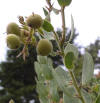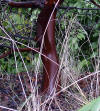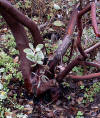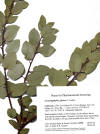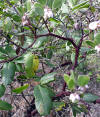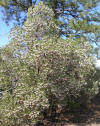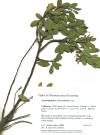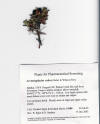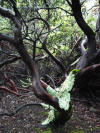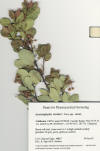|
Arctostaphylos andersonii
|
Arctostaphylos canescens
ssp. canescens |
 
Arctostaphylos canescens
ssp. sonomensis
|
Arctostaphylos catalinae |
Arctostaphylos
confertiflora |
|
Arctostaphylos crustacea
ssp. crustacea
|
Arctostaphylos crustacea
ssp. insulicola
|
Arctostaphylos crustacea
ssp. rosei
|
Arctostaphylos franciscana
|
Arctostaphylos
gabilanensis
|
|
Arctostaphylos glandulosa ssp. glandulosa Table Mt., Oregon. Aug 2011 |
Arctostaphylos glandulosa
ssp. mollis
|
Arctostaphylos glandulosa
|
Arctostaphylos glandulosa
|
Arctostaphylos glauca
|
|
Arctostaphylos glauca
|
Arctostaphylos glauca
|
Arctostaphylos glauca
|
Arctostaphylos hookeri ssp. hearstiorum.
|
Arctostaphylos hookeri ssp. hookeri. |
|
Arctostaphylos imbricata
|
Arctostaphylos manzanita
ssp. roofii |
Arctostaphylos manzanita
|
Arctostaphylos manzanita
|
Arctostaphylos montaraensis |
|
Arctostaphylos morroensis
|
Arctostaphylos nevadensis
|
Arctostaphylos nevadensis |
Arctostaphylos nevadensis
|
Arctostaphylos nevadensis
|
|
Arctostaphylos
obispoensis
|
Arctostaphylos pajaroensis
|
     Arctostaphylos parryana Kern Co.: Mt. Pinos, CA 24 Oct 2011 |
Arctostaphylos patula |
Arctostaphylos patula |
    California: Kern Plateau, Kern Co., Little Cannel Meadow, near Tulare Co. line, 26 June 2015. (1) Arctostaphylos viscida and A. patula. (2). A. patula, (3) A. viscida, (4) Arctostaphylos viscida x patula |
Arctostaphylos patula
|
Arctostaphylos patula
|
Arctostaphylos patula |
Arctostaphylos patula
|
|
Arctostaphylos patula |
Arctostaphylos pilosula
|
Arctostaphylos pringlei
ssp. pringlei
|
Arctostaphylos pungens |
Arctostaphylos pungens |
|
Arctostaphylos pungens
|
Arctostaphylos
rainbowensis
|
Arctostaphylos rubra
|
Arctostaphylos rudis
|
Arctostaphylos
stanfordiana
|
|
Arctostaphylos subcordata
|
Arctostaphylos tomentosa
subsp. bracteosa
(Arctostaphylos tomentosa
var. trichoclada) |
Arctostaphylos tomentosa |
Arctostaphylos tomentosa
ssp. tomentosa.
|
Arctostaphylos uva-ursi |
|
Arctostaphylos uva-ursi f.
coactilis
|
Arctostaphylos viscida Kern Co. Breckenridge Mt.,
CA |
Arctostaphylos viscida |
Arctostaphylos viscida |
Arctostaphylos viscida
ssp. mariposa |
|
Arctostaphylos viscida
ssp. mariposa |
Arctostaphylos viscida
ssp. pulchella |
Arctostaphylos viscida
|
Arctostaphylos viscida
ssp. viscida
|
|
  Arctostaphylos viscida
ssp. viscida |
Arctostaphylos viscida
ssp. viscida
|
Arctostaphylos viscida
|
     Arctostaphylos viscida,
A. patula and intermediates,
Greenhorn Mountains, east and south slopes of Sunday Peak, 23 Oct
2013. (1) Stand of arborescent A. patula (probably hybrid), (2)
A. viscida intermediate (left), A. viscida (right), and
leaves of A. patula (far right edge of photo). (3) Close-up of
A. viscida, and (4) of A. patula, and (5) of putative
A. viscida x patula
|
|
  Arctostaphylos sp. aff. columbiana. French Hill Rd, Del Norte Co., CA. Aug 2011. Burl apparent but not obvious, young twigs with short whitish bent hairs, with short and long straight hairs, and with sessile glands; leaves with whitish short bent hairs; inflorescence a single axis, pendant; bracts leaf-like, not ciliate along margins; pedicel 1–2 mm, glabrous; fruit depressed globose with distinct pyrenes. |
 
Arctostaphylos
sp. aff.
columbiana |
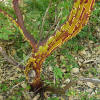 
Arctostaphylos sp. aff.
columbiana
|
Arctostaphylos canescens
x patula
|
|
|
Trees and Shrubs of Kern County (Sep 2012) Arctostaphylos (Greek: bear berry). Shrubs or small trees reproducing by burl, rooting branches (layering), and/ or by seed; bark smooth or peeling, red; stems and twigs smooth, red; leaves alternate, usually leathery, entire (or slightly toothed in young plants); flowers usually on terminal flowering scape-like stems (inflorescences), the flowers buds formed during late summer (embryonic inflorescences), remaining dormant until late fall or winter when flowering commences; flowers often clustered along shortly branched (“panicle”) or unbranched (“raceme”) scape-like stems; flowers urn-shaped, white to pink; fruits often persist for many months, berry-like in appearance, reddish to orange in most species, texture more like a potato, or merely the outer layer a skin-like cover over a hardened endocarp (stone) in 4–5 species, generally regarded as a nuculanium, the stone 2–10 locular, usually separating at maturity into its locular (carpellary) parts or pyrenes (“nutlets, “stones” in the literature), each containing one seed. Besides the species mentioned below, several others reported for the County in CCH, A. canescens and A. manzanita, were excluded because their occurrence in the county is well outside the range reported for the species. Arctostaphylos contains 66 species with nearly half of them found along a very narrow region of the California Central Coast (Parker, Vasey & Keeley 2009). Jepson (1919) recognized 25 species of Arctostaphylos. That number more than doubled in later floras, e.g., 57 species in The Jepson Manual (Hickman 1993). A justification for recognizing many species in the genus is the relatively few species that occur along the Sierra Nevada over a broader geographical range (Jepson 1919). Early floristic treatments (Abrams; Munz and Keck) recognized varieties that have since been elevated to subspecies (Philip Wells in JM1; Parker, Vasey & Keeley in JM2). Whether these are varieties or subspecies seems debatable, especially in view that natural hybrids are common. In JM1, the key by Wells leads to a species immediately followed by a key to all its subspecies. In JM2 (Parker, Vasey & Keeley), subspecies of a species often key out in multiple places, making it difficult to learn the distinctive features of species as well as intraspecific variation; however, the same authors have provided a key to the subspecies within a species in FNA. Characters used to distinguish species of Arctostaphylos rely largely on field observations. These include presence or absence of burl, persistence of bark, color of leaves, erect or pendulous embryonic inflorescences (especially during the late summer), and whether or not the fruit endocarp separates into pyrenes. The taxonomic significance of a burl was discussed in detail by Jepson (1919). It is the first step in the keys in JM2 and FNA. Unfortunately, manzanita species often grow among other shrubs in dense vegetation where it can be difficult to see the base of the plant, or the plants may be large mounds where one might assume that a burl is not a key attribute. The practical use of this character therefore needs to be taken into consideration when constructing keys as seen in earlier treatments. The manzanita species in Twisselmann and Moe are generally recognized by the Jepson Manuals and FNA to lack a burl; however, plants that might otherwise key to A. viscida in Kern County, and also Tulare Co., clearly have a burl. They also differ in having shorter thicker embryonic inflorescences. Similar plants on Breckenridge Mountain reproduce by layering instead of a burl. These appear to be distinct subspecies of A. viscida or a distinct species. CCH specimens from Kern County identified as A. glandulosa are probably this species (A. viscida); A. glandulosa, which is distinguished from A. viscida by the leaf-like bracts, does not appear to occur in Kern County. The embryonic flower clusters (“nascent inflorescence”), which usually develop by summer, appear distinctive for many species (Jepson 1919; FNA, JM1, JM2). Unfortunately, their differences are not easily visualized from species descriptions, while most images of species inflorescences show plants in full flower. Ten species of Arctostaphylos have been used medicinally by native American tribes (Moerman); A. uva-ursi, a circumboreal species, is the most extensively used and studied pharmacologically. A glycosylated hydroquinone, known as arbutin, reportedly has been clinically effective in treating bladder and kidney ailments, and inhibits human bladder cancer cell proliferation (H. Li et al. 2011). The NCI screened 92 extracts of Arctostaphylos prior to 1980 from which an aqueous-ethanol extract of a plant-fruit sample of A. pringlei ssp. pringlei collected in Apr 1966 from Crown King, AZ was active in a solid tumor (WA). The WBA collected a dried fruit sample of A. glauca during the 1980’s that was active in a chemopreventive assay, but no published reports on the active agents could be found. Samples from ~18 species of Arctostaphylos have been collected for the NCI since 1996. Key to Arctostaphylos Species 1. Leaves whitish green............................................................................................................... 2 1. Leaves green but not whitish green.......................................................................................... 4
2. Bracts of floral
axis triangular-tongue-like, green, sticking-out
2. Bracts of axis
appearing like manicured finger-nails, often “painted”
...... 3a Plants reproducing strictly by seed, lacking burl,
branches
...... Twigs with gland-tipped
hairs......................................................................
ssp. mariposa
4. Twig hairs
gland-tipped; leaves spreading widely, the petioles often at
4. Twigs hairy but not
with glands at their tips; leaves mostly erect ...... 5. Plants trailing along the ground ............................................ Arctostaphylos nevadensis ...... 5. Plants with evident central basal stems............. ............................................................. 6
6. Flowers/fruits on
pedicels radiating in an umbel-like arrangement from near
6. Flowers/fruits on
pedicels arising along a shortly branched
7. Plants often huge
round mounds, evidently without a burl but with
7. Plants with erect
stems from a burl; twigs white hairy, the hairs
Arctostaphylos glandulosa Eastwood 1897 ssp. mollis (var. glandulosa J.E. Adams 1940) P.V. Wells 1968. [Includes A. glandulosa ssp. glaucomollis P.V. Wells 1987]. Soft hairy manzanita in regard to hairs on twigs. Upright shrub with basal burl, 1–4 m high, twigs with short and long wavy glandless hairs; bracts of flower clusters leaf-like with conspicuous white hairs, especially along margins; flowering winter to early spring; ovary densely white hairy. The subspecies is mainly found in the Transverse and Peninsular Ranges, 600–2,000 m. The typical subspecies occurs throughout the Coast Ranges of California, extending into Oregon. MCV2 recognizes an Eastwood manzanita chaparral with “>60% relative cover in the shrub canopy” to occur through the range of the species, briefly noting the geographical subspecies and that the species in general is most common in southern California at the higher elevations of chaparral. Type from La Cumbre Creek, Santa Barbara Co., CA. Kern Co.: Rare: Three records in CCH: 5 mi northeast of Castac Lake, 1,036 m (G. T. Nordstrom, Apr 1935); Tehachapi Mts, ca. 9.3 mi ENE of Lebec, in Bear Trap Canyon, chaparral, 1,325 m, Preston, 15 may 2007; Tehachapi Mts., Johnson Canyon above Bear Trap Canyon, ~ 7 miles NE of Lebec in vicinity of Calif. Aqueduct tunnel, 1006–1067 m, oak woodland and chaparral on canyon slopes with Quercus kelloggii, Q. wislizeni, Q. lobata, Q. douglasii, Aesculus californica, Arctostaphylos, Adenostoma, Rhamnus ilicifolia, Sanders & Provance, 1 Jun 2007 [as ssp. glaucomollis; in JM1 distingiushd by leaf color, green in ssp. mollis, gray green in ssp. glaucomollis]. Arctostaphylos glandulosa ssp.? Sierra Nevada: Long Valley Campground near Chimney Peak Wilderness Area, in Long Valley just outside SE corner of Sequoia National Forest, 28 km NE of Lake Isabella; pinyon woodland, in sandy wash, surrounding rolling hills and road cut with Quercus chrysolepis, Pinus sabiniana, and Fraxinus velutina (CCH: D. Charlton, 13 May 1989). The species has not been reported from the Sierra Nevada. One might expect A. viscida or A. patula in this region. [Update: Sep 2015: record reidentified in CCH to A. glauca). Arctostaphylos glauca Lindley 1836. Big berried manzanita. Usually erect stemmed shrub without a burl, to 8 m high, or forming broad rounded mounds in the Transverse Ranges; generally distinguished by the whitish green leaves and relatively large resinous (sticky) fruit (nuculanium) with a single stone; flowering Dec–Feb; flower scapes with subtending narrow green bracts that are wide-spreading and recurved. A central and southern California species of the drier chaparral and desert margins, 150–1200 (-1700) m, extending south to the Sierra San Borja in central Baja California. MCV2 recognized Bigberry manzanita chaparral when >60% relative cover in the shrub canopy. Type from Coast Ranges of California. Kern Co. Common in the central part of the Temblor Range, and in Bear Trap Canyon of the Tehachapi Mountains (Twisselmann), 800–1,463 m (CCH: collections from Sierra Nevada region excluded). CCH and other reports suggests it may occur in the Southern Sierra Nevada (1 mi E of Cedar Springs Campground along Hwy 155 (Susan James, UCR), and Hobo Ridge off Lower Breckenridge Road (David Charlton). These may prove to be A. viscida, which is frequent near Greenhorn Pass. MCV2 mentioned its occurrence at Walker Pass. This would be within its geographical range along the edge of the desert; however, there are no manzanita specimens in CCH from Walker Pass; A. glauca is generally known from Cajon Pass, which is outside Kern County. Arctostaphylos glauca differs from A. viscida by the fruit not dividing into pyrenes (nuculanium, of a single stone), 12–15 mm diam., in contrast to the pyrenarium (divided into pyrenes) of A. viscida, 6–8 mm diam. The fruits of A. glauca have been consumed as food, which led the WBA to collect a sample for chemopreventive screening by the Ohio State University in the 1980's. It was found active; recollections of 50 kg were later obtained from the desert edge in the San Bernardino Mts. for isolation of the active agents, but not known to have been reported. Arctostaphylos nevadensis A. Gray1878. Pinemat manzanita. Shrubs with main branches creeping along the ground forming broad mats; leaves widest above base, tapering to an acute apex; flowering in June. Common in the understory of montane coniferous forest, between 5,000 and 10.000 ft; Rocky Mts. in Canada to Cascade Ranges, south to the North Coast Ranges and Sierra Nevada in California. Type from Sierra Nevada, 8,000–10,000 ft. Kern Co.: Numerous colonies in the red fir forest on the north slope of Sunday Peak, the southern distribution limits of the species (Twisselmann), 2,134–2,535 m (CCH). Arctostaphylos parryana Lemmon 1890 ssp. parryana. Parry manzanita, Kolul manzanita. Isolated or colonial shrubs broader than high, without a burl, mound forms 3–6+ m diam., other forms similar in habit to A. patula in having decumbent branches that take root, 1.0–2.0 m high; young twigs with small curly white hairs as seen under 20x; leaves mostly erect, or wide spreading as in A. patula, often with a short apical point, narrowed to petiole; flowering March; flowers arranged along 1–several short scape-like branches developing from an embryonic inflorescence of closely imbricate appressed to slightly spreading manicured finger-nail like bracts; fruit with a single stone. Dry slopes in conifer forests, 1,500–2,560 m; Southern Sierra Nevada and Mount Pinos Region, Transverse Ranges, Ventura and Santa Barbara Cos. south to eastern slopes of San Gabriel and San Antonio Mts. to desert slopes of mountains in northern Baja California (ssp. desertica?). Type from 4 miles south of Keene, Tehachapi Mts. in Kern Co., CA. Kern Co.: “Occasional from the Douglas oak woodland and the chaparral to the yellow pine forest from the Mt. Abel region through the Tehachapi Mountains northeast to the Cache Peak region” (Twisselmann), 904–,2,400 m (CCH). Parry manzanita is never densely colonial and often occurs as isolated individuals” (Twisselmann). Two other subspecies occur further south. (Twisselmann). The pulp from grounded fruits are sometimes consumed for food. Arctostaphylos patula Greene 1891. Green leaf manzanita. Shrub widely branched near base, stems arising from a woody root crown at or below surface, branches also touching the ground and often rooting, commonly 1.0 to 1.5 m high and broad, or often broader than high and mound like; leaves widely divergent on long petioles, the blades often widest at or near base and many on a plant are truncated; flowering Mar–May. This species is one of a small number in a large genus with a widespread distribution—occurring throughout the montane forests in California, 750–3,300 m, west to Montana and Colorado, south to New Mexico, Arizona and northern Baja California. It forms dense thickets in northern California. Rattlesnakes are reportedly numerous under the manzanita thickets. Green leaf manzanita chaparral recognized in MCV2 when >60% relative cover in the canopy. Type from pine woods at middle elevations in the Sierra Nevada, CA. Kern Co.: “Common in the yellow pine forest in the Greenhorn Range, the Piute Mountains, and on the Kern Plateau” (Twisselmann), 1,372–2,505 m (CCH). Arctostaphylos pungens Kunth 1819 Mexican manzanita, Pointleaf manzanita. An erect shrub to 2 m or more, twigs and floral axes hairy but without glands; leaves glabrous; flowering Feb–Mar; pedicels glabrous. Utah to California south to mountains of Oaxaca, Mexico and Sierra San Pedro Mártir in Baja California. Type from the mountains slopes near the city of Mexico. Kern Co. “Occasional from the chaparral through the Jeffrey pine forest in the Mt. Pinos region and along the east slope of the Tehachapi Mountains west of Antelope Valley” (Twisselmann), 1,250–1,828 m. Leaves of A. pungens used as a remedy in Arizona for treating stomach troubes (Krochmal et al. 1954). Arctostaphylos viscida Parry 1887. White leaf manzanita. Large shrubs with whitish green leaves, with or without burl, or layering; flowering Mar–Apr; flowers on pedicels from branches that diverge along a main axis, the side flowering branches gradually becoming shorter towards apex of the main axis, the whole inflorescence pyramidal in outline (thyrse); pedicels viscid (glandular), 6–10 mm. Occurring in chaparral, woodland and forest of the Sierra Nevada, 150–1,400 m. White leaf manzanita chaparral recognized in MCV2 when >30% relative cover in the shrub canopy. Type from the foothills of the Sierra Nevada. Two–four subspecies: Ssp. viscida with hairless twigs, western Sierra Nevada, Ssp. mariposa (A. mariposa Dudley 1902) P.V. Wells (Mariposa manzanita) with glandular tipped hairs on twigs, occur in the west-central Sierra Nevada, 200–1,200 m; Type from Millwood and Kings River canyons, southern Sierra Nevada, CA. Ssp. indet.1: burl present, embryonic flower clusters shorter and thicker than preceding subspecies, southern Sierra Nevada, Kern Co., Tulare Co, and possibly further north, and Ssp. indet. 2: plants clonal, Breckenridge Mt. Kern Co. Ssp. mariposa reported by Twisselmann to be common in the montane forests of the Sierra Nevada region south to Piute Mountains, ranging from 1,066–2,011 m (CCH). Ssp. viscida considered less common by Twisselmann, but more records in CCH. 1,121–2,025 m. The species is recognized in the literature to lack a basal burl; however, plants in Kern County, which appear to belong to this species by the glandular inflorescences and twigs, and lack of leaf-like bracts subtending the infloresences, have a burl, or appear clonal.
|
||||
|
Some References on Pharmacological Activity in Arctostaphylos Li, H, Y. M. Jeong, S. Y. Kim, M. K. Kim and D. S. Kim. 2011. Arbutin inhibits TCCSUP human bladder cancer cell proliferation via up-regulation of p21. Pharmazie 66(4): 306–09. Arbutin is a glycosylated hydroquinone extracted from the bearberry plant (Arctostaphylos species). In the present study, we determined the effects of arbutin on TCCSUP human bladder carcinoma cell proliferation. Arbutin did not exhibit any cytotoxic effects in TCCSUP cells at concentrations of < 500 microg/ml. To determine the effects of arbutin on cell proliferation, TCCSUP cells were treated with arbutin at various concentrations, and the cell proliferation was measured using the MTT assay. Arbutin significantly decreased TCCSUP cell proliferation in a concentration- and time-dependent manner. Furthermore, cell cycle analysis revealed that arbutin strongly disrupted the cell cycle in a time-dependent manner. Western blot analysis demonstrated that arbutin led to the inactivation of extracellular signal-regulated kinase (ERK), which is known to critically regulate cell proliferation. In addition, arbutin markedly increased the expression of p21WAF1/CIP1 (p21), which is known to be highly involved in cell cycle regulation. Therefore, this study suggests that arbutin inhibits TCCSUP cell proliferation via ERK inactivation and p21 up-regulation. Chauhan B., C. Yu, A. Krantis, I. Scott, J. T. Arnason, R. J. Marles and B. C. Foster. 2007. In vitro activity of uva-ursi against cytochrome P450 isoenzymes and P-glycoprotein. Can. J. Physiol. Pharmacol. 85(11):1099–1107. “Some natural health products (NHPs) affect drug metabolism enzymes and transport proteins, potentially affecting the safety and efficacy of the drug or other NHPs. This study was undertaken to characterize the effect of uva-ursi (Arctostaphylos uva-ursi) on cytochrome P450 isozyme (3A4, 3A5, 3A7, 2C19, and 19)-mediated metabolism and P-glycoprotein (P-gp) transport. Three bulk and 2 capsulated uva-ursi samples were obtained from commercial outlets. The capsules were batched, and herbal samples were ground to a common consistency. Aqueous and methanol extracts were freshly prepared. Cytochrome P450 isozyme-mediated metabolism was determined by using in vitro bioassays. P-gp transport function was determined by using a rhodamine 123 (Rh123) uptake test in human (THP-1) monocytes and human Caco-2 cells. All products were analyzed by HPLC for arbutin, gallic acid, myricitrin, and isoquercetin. A large variation was observed in the biomarkers found between the bulk and capsulated samples. Our data indicate that both the aqueous and methanol extracts of all 5 uva-ursi products showed high cytochrome P450 isozyme inhibition, with the exception of the methanol extracts against cytochromes P3A4 and P19, which had low to moderate activity. The aqueous extracts of uva-ursi showed an inhibitory effect on Rh123 efflux by P-gp at 1 h and an inductive effect at 18 h for both cell lines. Our results show that the uva-ursi herbal products tested here have pharmacological properties, including the potential capacity to affect drug safety and efficacy. Further studies are warranted agaist a wider range of cytochrome P450 isozymes and to determine whether these effects are clinically significant.” Farnsworth N. R., H. Wagner, L. Horhammer and G. H. Constantine. 1967. Proper identification of the n-alkane from Arctostaphylos patula. J. Pharm. Sci. 56(11): 1534. Matsuda H., T. Tanaka and M. Kubo. Pharmacological studies on leaf of Arctostaphylos uva-ursi (L.) Spreng. III. 1991. Combined effect of arbutin and indomethacin on immuno-inflammation. Yakugaku Zasshi 111(4-5): 253-8. In Japanese. Unpublished Taxonomic Reference Spjut, R. W. 2011. Key to Arctostaphylos species in California by geographical regions
|
||||





